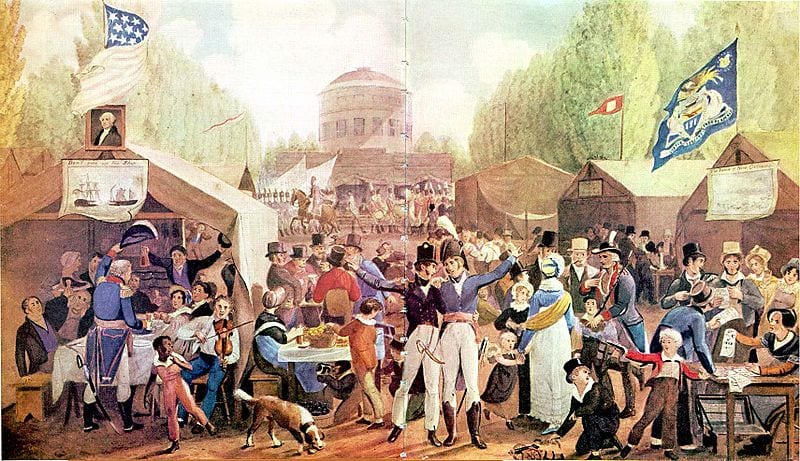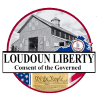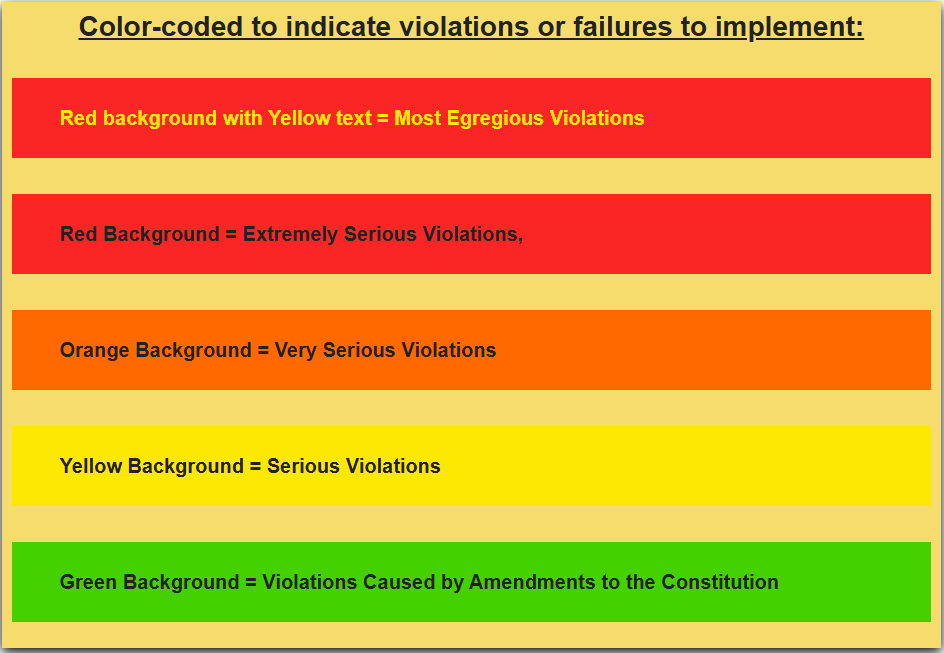
The US Constitution Ratification Debates: Federalists vs. Anti-Federalists
The ratification of the U.S. Constitution was a defining moment in American history, sparking intense debates across the nation. After the Constitutional Convention of 1787, the proposed Constitution required approval from at least nine of the thirteen states. This process ignited a clash between two groups: the Federalists and the Anti-Federalists. These US Constitution Ratification Debates shaped the nation’s government and secured individual rights through the Bill of Rights. In this article, we dive into the key arguments, concerns, and lasting legacy of this pivotal event.
Federalists vs. Anti-Federalists: The Heart of the Debate
The ratification debates hinged on the opposing visions of the Federalists and Anti-Federalists.
Federalists: Champions of a Strong Central Government
Led by Alexander Hamilton, James Madison, and John Jay, the Federalists supported the Constitution. They argued that a robust central government was essential to fix the weaknesses of the Articles of Confederation. A unified system, they believed, would ensure national stability, economic growth, and global influence. Their arguments were famously outlined in The Federalist Papers, a cornerstone of American political thought.
Anti-Federalists: Guardians of State Power and Liberty
The Anti-Federalists, including Patrick Henry and George Mason, opposed a strong federal government. They feared it could lead to tyranny, undermining state sovereignty and individual freedoms. A major sticking point was the absence of a Bill of Rights, which they deemed critical to protect citizens from government overreach.
Key Issues in the Ratification Debates
Several core concerns fueled the Federalists vs. Anti-Federalists divide.
Representation: Could a Large Republic Work?
Anti-Federalists worried that a vast republic would fail to represent the people effectively. They argued that large congressional districts would disconnect representatives from their constituents.
Checks and Balances: Safeguarding Against Tyranny
Both sides valued checks and balances, but Anti-Federalists doubted the Constitution’s system would prevent power abuses. Federalists countered that dividing power among branches would protect liberty.
The Bill of Rights: A Dealbreaker
The lack of a Bill of Rights was a flashpoint. Anti-Federalists demanded explicit protections, while Federalists initially saw them as unnecessary. This disagreement shaped the ratification outcome.
State-by-State Ratification: A Hard-Fought Battle
Ratification unfolded differently across the states:
- Delaware, Pennsylvania, and New Jersey ratified quickly.
- Massachusetts approved after debate, contingent on amendments.
- New York and Virginia saw fierce conventions but ratified narrowly, swayed by promises of a Bill of Rights.
By June 1788, nine states had ratified, activating the Constitution. The addition of New York and Virginia ensured its success.
The Legacy of the Ratification Debates
The debates didn’t end with ratification. Anti-Federalist pressure led to the Bill of Rights in 1791, guaranteeing freedoms like speech and religion. The US Constitution Ratification Debates also sparked enduring discussions about state vs. federal power, shaping American democracy.
Synopsis and Full Text Archive per State
- Delaware
- New Jersey
- Georgia
- Connecticut
- Maryland
- New Hampshire
- Rhode Island
- Pennsylvania
- Massachusetts
- South Carolina
- Virginia
- New York
- North Carolina
Delaware Ratification Debates
I. Key Issues
A. Federal vs. State Power
- Federalists: Advocated for a strong central government to unify the states and enhance trade and security, crucial for a small state like Delaware.
- Anti-Federalists: Expressed minimal concern, as Delaware saw benefits in a stronger union and had little fear of federal overreach.
B. Lack of Bill of Rights
- Anti-Federalists: Raised few objections, as the focus was on practical advantages rather than individual rights.
- Federalists: Emphasized economic and defensive benefits, downplaying the need for explicit protections.
C. Representation
- Equal representation in the Senate was viewed favorably by Delaware, ensuring influence despite its small size, with little debate over the House’s structure.
D. Checks and Balances
- Minimal discussion occurred, with trust in the Constitution’s balanced system prevailing among delegates.
E. Ratification Process
- The process was swift and faced little opposition, reflecting Delaware’s strong Federalist support and desire to join the union.
II. Key Events
A. The Call for a Convention
- The Delaware legislature, dominated by Federalists, called for a convention in late 1787, prioritizing quick action to secure federal benefits.
B. The Ratification Convention
- Held on December 7, 1787, in Dover. Federalists, led by figures like John Dickinson, dominated, and debates were brief, focusing on the advantages of union. Delaware ratified unanimously (30 to 0), becoming the first state.
C. The Ratification Vote
- On December 7, 1787, the convention voted 30 to 0 in favor of ratification, reflecting broad consensus.
D. Public Debates and Pamphlets
- Public discourse was limited, with few pamphlets or writings due to the lack of significant opposition.
E. The Role of the Press
- Newspapers reported the swift, unanimous ratification positively, reinforcing Delaware’s support for the Constitution.
View/Download/Share as Word doc
New Jersey Ratification Debates
I. Key Issues
A. Federal vs. State Power
- Federalists: Supported a strong central government to regulate commerce and defense, benefiting small states like New Jersey.
- Anti-Federalists: Offered limited opposition, as most saw advantages in federal authority.
B. Lack of Bill of Rights
- Anti-Federalists: Raised minimal concerns, overshadowed by economic priorities.
- Federalists: Focused on practical benefits rather than individual rights.
C. Representation
- Equal representation in the Senate was advantageous for New Jersey, with little debate over the House’s structure.
D. Checks and Balances
- Delegates expressed confidence in the Constitution’s balanced system, with no significant opposition.
E. Ratification Process
- The process was swift and uncontroversial, driven by Federalist dominance.
II. Key Events
A. The Call for a Convention
- New Jersey’s legislature, led by Federalists, called for a convention in late 1787 with broad support.
B. The Ratification Convention
- Held from December 11 to December 18, 1787, in Trenton, Federalists like William Paterson led brief discussions on the Constitution’s benefits for small states.
C. The Ratification Vote
- On December 18, 1787, the convention voted unanimously (38 to 0) to ratify.
D. Public Debates and Pamphlets
- Public discourse was minimal, with few pamphlets due to widespread agreement.
E. The Role of the Press
- Newspapers reported the unanimous ratification favorably, highlighting New Jersey’s support for the union.
View/Download/Share as Word doc
Georgia Ratification Debates
I. Key Issues
A. Federal vs. State Power
- Federalists: Advocated for a strong central government to provide defense against Native American threats and regulate commerce.
- Anti-Federalists: Showed minimal opposition, as Georgia’s security needs outweighed sovereignty concerns.
B. Lack of Bill of Rights
- Anti-Federalists: Did not prioritize this issue, given the focus on immediate security.
- Federalists: Emphasized practical benefits over individual protections.
C. Representation
- Equal representation in the Senate was favorable for Georgia, a smaller state, with little contention.
D. Checks and Balances
- Delegates trusted the Constitution’s structure, with no notable debates.
E. Ratification Process
- The process was expedited due to Georgia’s urgent need for federal support.
II. Key Events
A. The Call for a Convention
- Georgia’s legislature called for a convention in late 1787, driven by security concerns.
B. The Ratification Convention
- Held from December 25, 1787, to January 2, 1788, in Augusta, Federalists like Abraham Baldwin led discussions on defense and economic stability.
C. The Ratification Vote
- On January 2, 1788, the convention voted unanimously (26 to 0) to ratify.
D. Public Debates and Pamphlets
- Public discourse was limited, reflecting the state’s consensus on ratification.
E. The Role of the Press
- Newspapers reported the swift ratification, emphasizing Georgia’s reliance on federal protection.
View / Download / Share as Word file
Connecticut Ratification Debates
Key Issues:
- Federal vs. State Powers:
- Centralization of Power: There was significant concern over the centralization of power in a federal government. Critics argued that the Constitution would give too much power to a distant central authority, potentially at the expense of state sovereignty.
- State Sovereignty: Advocates for the Constitution argued that a stronger federal government was necessary for national unity and defense, but this was met with fears that states would lose their autonomy.
- Lack of a Bill of Rights:
- Rights of Citizens: One of the most contentious issues was the absence of a Bill of Rights in the original document. Anti-Federalists argued that without explicit protections for individual liberties, the federal government could potentially overstep into personal freedoms.
- Representation:
- Small States vs. Large States: Connecticut, being a smaller state, was concerned about representation in the new federal system. The Great Compromise (Connecticut Compromise) had already addressed this in the Constitutional Convention by establishing equal representation in the Senate and proportional representation in the House, but there was still debate over its effectiveness.
- Economic Concerns:
- Taxes and Regulation: There were worries about how the federal government would impose and regulate taxes, which could disproportionately affect states with different economic bases.
- Judiciary Power:
- Judicial Review: The concept of an independent judiciary with the power of judicial review was novel and controversial. There was apprehension about the judiciary potentially overstepping its bounds.
Events:
- Convention in Hartford:
- Connecticut held its ratification convention in Hartford in January 1788. This was where the debates took place.
- Public Discussions and Essays:
- Leading up to and during the convention, there were numerous essays and public discussions. Federalist and Anti-Federalist ideas were disseminated through newspapers and pamphlets, notably “The Federalist Papers” by Alexander Hamilton, James Madison, and John Jay, which, while not directly aimed at Connecticut alone, influenced the national debate.
- Voting on Ratification:
- On January 9, 1788, Connecticut voted to ratify the Constitution. The vote was relatively swift, reflecting a strong Federalist sentiment or at least a pragmatic acceptance of the necessity for a stronger national government. Connecticut became the fifth state to ratify the Constitution.
- Post-Ratification:
- After ratification, there was still considerable debate over amendments to include a Bill of Rights. Connecticut delegates at the First Congress supported amendments that would eventually become part of the Bill of Rights.
Outcome:
- Ratification: Connecticut ratified the Constitution by a significant margin, indicating a general acceptance of the need for a stronger federal government despite the concerns raised.
- Influence on the Bill of Rights: The ratification debates in Connecticut, like in other states, contributed to the push for the Bill of Rights, influencing the first ten amendments to the U.S. Constitution.
These debates underscored the tension between federal power and state rights, a theme that would continue to influence American political discourse for centuries.
Maryland Ratification Debates
I. Key Issues
A. Federal vs. State Power
- Federalists: Supported a strong central government for unity and economic stability.
- Anti-Federalists: Feared federal overreach and loss of state sovereignty.
B. Lack of Bill of Rights
- Anti-Federalists: Argued it endangered liberties.
- Federalists: Claimed existing protections were sufficient but faced amendment demands.
C. Representation
- Some concerns about Senate representation were raised but did not dominate.
D. Checks and Balances
- Anti-Federalist worries about executive and judicial powers were addressed by Federalists.
E. Ratification Process
- The process was contentious, with Anti-Federalists seeking delays.
II. Key Events
A. The Call for a Convention
- Maryland’s legislature called for a convention in late 1787, pushed by Federalists.
B. The Ratification Convention
- Held from April 21 to April 29, 1788, in Annapolis, Federalists (James McHenry) overcame Anti-Federalist (Luther Martin) resistance.
C. The Ratification Vote
- On April 28, 1788, the convention voted 63 to 11 in favor of ratification.
D. Public Debates and Pamphlets
- Anti-Federalist critiques circulated but were outmatched by Federalist writings.
E. The Role of the Press
Newspapers published Federalist arguments, securing public support.
View/Share/Download as Word doc
New Hampshire Ratification Debates
I. Key Issues
A. Federal vs. State Power
- Federalists: Supported a strong central government for economic and defense needs.
- Anti-Federalists: Feared loss of state control.
B. Lack of Bill of Rights
- Anti-Federalists: Demanded protections for liberties.
- Federalists: Promised amendments, securing ratification.
C. Representation
- Concerns about Senate representation were eased by amendment promises.
D. Checks and Balances
- Anti-Federalist fears of executive power were addressed by Federalists.
E. Ratification Process
- The process was contentious, requiring two conventions.
II. Key Events
A. The Call for a Convention
- New Hampshire called for a convention in late 1787.
B. The Ratification Convention
- Initially met in February 1788, adjourned, and reconvened in June 1788 in Concord. Federalists (John Sullivan) overcame Anti-Federalist (Joshua Atherton) resistance with amendments.
C. The Ratification Vote
- On June 21, 1788, the convention voted 57 to 47 in favor of ratification, making it the ninth state.
D. Public Debates and Pamphlets
- Both sides published arguments, with Federalists gaining ground.
E. The Role of the Press
Newspapers influenced the final decision with Federalist arguments.
View/Share/Download as Word doc
Rhode Island Ratification Debates
I. Key Issues
A. Federal vs. State Power
- Federalists: Advocated for a strong government for economic stability.
- Anti-Federalists: Feared loss of control over currency and commerce.
B. Lack of Bill of Rights
- Anti-Federalists: Demanded protections.
- Federalists: Promised amendments after resistance.
C. Representation
- Concerns about representation delayed action.
D. Checks and Balances
- Anti-Federalist fears of tyranny fueled opposition.
E. Ratification Process
- Initially resisted, with a late convention under pressure.
II. Key Events
A. The Call for a Convention
- Rhode Island refused initially, holding a referendum rejecting it in 1788.
B. The Ratification Convention
- Held from May 24 to May 29, 1790, in Newport, Federalists (James Varnum) overcame Anti-Federalists (Jonathan Hazard) under economic pressure.
C. The Ratification Vote
- On May 29, 1790, the convention voted 34 to 32 in favor of ratification.
D. Public Debates and Pamphlets
- Anti-Federalist writings dominated until late.
E. The Role of the Press
Newspapers reflected resistance, later shifting to support.
View/Share/Download as Word doc
Pennsylvania Ratification Debates
I. Key Issues
A. Federal vs. State Power
- Federalists: Argued for a strong central government to unify the states, ensure national defense, regulate commerce, and handle foreign affairs, addressing the Articles of Confederation’s weaknesses.
- Anti-Federalists: Feared a tyrannical central government and advocated for states’ rights and individual liberties.
B. Lack of Bill of Rights
- Anti-Federalists: Highlighted the absence of a Bill of Rights as a critical flaw, arguing it endangered personal freedoms.
- Federalists: Claimed the Constitution’s structure provided sufficient safeguards but faced pressure to promise amendments.
C. Representation
- Debates focused on proportionate representation in the House and equal representation in the Senate, with some Anti-Federalists viewing the latter as undemocratic.
D. Checks and Balances
- Concerns centered on the executive’s powers and judicial appointments, with Anti-Federalists wary of overreach; Federalists defended the system’s balance.
E. Ratification Process
- The process was contentious, with Federalists bypassing the state legislature to call a convention, seen as a tactic to sidestep Anti-Federalist resistance.
II. Key Events
A. The Call for a Convention
- The Pennsylvania Assembly, dominated by Federalists, called for a ratification convention in late 1787, criticized by Anti-Federalists as rushed and undemocratic.
B. The Ratification Convention
- Held in December 1787 in Philadelphia, the convention featured intense debates between Federalists (e.g., James Wilson) and Anti-Federalists (e.g., Robert Whitehill). Federalists held the majority.
C. The Ratification Vote
- On December 12, 1787, the convention voted 46 to 23 in favor of ratification, one of the narrower margins among early states.
D. The Circular Letter
- Post-ratification, Anti-Federalists issued a circular letter warning other states of the Constitution’s dangers without a Bill of Rights, influencing subsequent debates.
E. Public Debates and Pamphlets
- Public discourse featured Federalist support from figures like Benjamin Franklin and Anti-Federalist critiques from “Centinel” (likely Samuel Bryan) in pamphlets and newspapers.
F. The Role of the Press
- Newspapers disseminated both Federalist and Anti-Federalist arguments, with the Federalist Papers and local writings shaping public opinion.
View/Share/Download as Word doc
Massachusetts Ratification Debates
I. Key Issues
A. Federal vs. State Power
- Federalists: Advocated for a strong central government to address the Articles’ weaknesses in defense and commerce.
- Anti-Federalists: Feared centralized power could undermine Massachusetts’ tradition of local governance.
B. Lack of Bill of Rights
- Anti-Federalists: Argued that without a Bill of Rights, personal freedoms were at risk.
- Federalists: Claimed the Constitution’s structure was sufficient but agreed to recommend amendments.
C. Representation
- Debates focused on the House’s proportionate representation versus the Senate’s equal representation, with amendments easing concerns.
D. Checks and Balances
- Concerns about executive and judicial powers were mitigated by Federalist assurances and amendment proposals.
E. Ratification Process
- The process was contentious, with Anti-Federalists criticizing its speed and lack of democracy.
II. Key Events
A. The Call for a Convention
- Federalists called for a convention in late 1787, criticized by Anti-Federalists as rushed.
B. The Ratification Convention
- Held from January 9 to February 7, 1788, in Boston, Federalists (Rufus King) and Anti-Federalists (Elbridge Gerry) debated fiercely, with amendments proposed by John Hancock securing ratification.
C. The Ratification Vote
- On February 6, 1788, the convention voted 187 to 168 in favor of ratification, with recommended amendments.
D. Public Debates and Pamphlets
- Pamphlets and newspapers like the Massachusetts Centinel featured arguments from both sides, with Samuel Adams’ support pivotal.
E. The Role of the Press
- Newspapers amplified the compromise, influencing other states’ debates.
View/Share/Download as Word doc
File Name: Massachusetts_Debates.docx
South Carolina Ratification Debates
I. Key Issues
A. Federal vs. State Power
- Federalists: Advocated for a strong central government to regulate commerce and defense.
- Anti-Federalists: Feared interference with slavery and state autonomy but were a minority.
B. Lack of Bill of Rights
- Anti-Federalists: Raised minor concerns, overshadowed by economic priorities.
- Federalists: Focused on practical benefits.
C. Representation
- The representation compromise was seen as favorable, with little contention.
D. Checks and Balances
- Delegates trusted the system’s balance, with minimal debate.
E. Ratification Process
- The process was smooth, with Federalist control.
II. Key Events
A. The Call for a Convention
- South Carolina’s legislature called for a convention in early 1788.
B. The Ratification Convention
- Held from May 12 to May 23, 1788, in Charleston, Federalists (Charles Pinckney) led discussions on economic benefits.
C. The Ratification Vote
- On May 23, 1788, the convention voted 149 to 73 in favor of ratification.
D. Public Debates and Pamphlets
- Some Anti-Federalist writings emerged but were overshadowed.
E. The Role of the Press
Newspapers like the Charleston Gazette supported ratification.
View/Share/Download as Word doc
File Name: South_Carolina_Debates.docx
Virginia Ratification Debates
I. Key Issues
A. Federal vs. State Power
- Federalists: Argued for a strong central government for defense and commerce.
- Anti-Federalists: Feared it would overshadow Virginia’s autonomy.
B. Lack of Bill of Rights
- Anti-Federalists: Insisted it was essential for freedoms.
- Federalists: Promised amendments, a key concession.
C. Representation
- Concerns about Senate representation were mitigated by Federalist assurances.
D. Checks and Balances
- Anti-Federalist fears of executive and judicial power were countered by Federalists.
E. Ratification Process
- Anti-Federalists resisted, seeking more deliberation.
II. Key Events
A. The Call for a Convention
- Federalists called for a convention in late 1787; Anti-Federalists favored a second convention.
B. The Ratification Convention
- Held from June 2 to June 27, 1788, in Richmond, Madison and Randolph debated Henry and Mason, with amendments securing ratification.
C. The Ratification Vote
- On June 25, 1788, the convention voted 89 to 79 in favor of ratification.
D. Public Debates and Pamphlets
- The Federalist Papers and Anti-Federalist writings fueled discourse.
E. The Role of the Press
Newspapers, with Federalist Papers, swayed opinion.
View/Share/Download as Word doc
New York Ratification Debates
I. Key Issues
A. Federal vs. State Power
- Federalists: Pushed for a strong federal government for trade and defense.
- Anti-Federalists: Feared loss of New York’s independence.
B. Lack of Bill of Rights
- Anti-Federalists: Argued it endangered liberties.
- Federalists: Promised amendments after initial resistance.
C. Representation
- Senate equality frustrated New York, but urgency prevailed.
D. Checks and Balances
- Anti-Federalist concerns were addressed by Federalist defenses.
E. Ratification Process
- Anti-Federalists sought a second convention, delaying action.
II. Key Events
A. The Call for a Convention
- Federalists called for a convention in early 1788; Anti-Federalists resisted.
B. The Ratification Convention
- Held from June 17 to July 26, 1788, in Poughkeepsie, Hamilton and Jay faced Clinton and Smith, with Virginia’s ratification pressuring agreement.
C. The Ratification Vote
- On July 26, 1788, the convention voted 30 to 27 in favor of ratification.
D. The Circular Letter
- Anti-Federalists issued a letter urging a second convention.
E. Public Debates and Pamphlets
- The Federalist Papers countered Anti-Federalist writings.
F. The Role of the Press
- Newspapers, especially Federalist Papers, shifted opinion.
View / Download / Share Using Buttons in Frame
North Carolina Ratification Debates
I. Key Issues
A. Federal vs. State Power
- Federalists: Supported a strong government for economic and defense needs.
- Anti-Federalists: Feared federal overreach.
B. Lack of Bill of Rights
- Anti-Federalists: Demanded explicit protections.
- Federalists: Promised amendments after initial rejection.
C. Representation
- Concerns about Senate and House structures delayed ratification.
D. Checks and Balances
- Anti-Federalist fears of tyranny contributed to initial rejection.
E. Ratification Process
- Highly contentious, requiring two conventions.
II. Key Events
A. The Call for a Convention
- Called in 1788, with Anti-Federalists dominant.
B. The Ratification Convention
- Held from July 21 to August 4, 1788, in Hillsborough, Anti-Federalists (Willie Jones) rejected it 184 to 84. A second convention in November 1789 in Fayetteville ratified it 194 to 77 after the Bill of Rights was proposed.
C. The Ratification Vote
- November 21, 1789, voted 194 to 77 in favor.
D. Public Debates and Pamphlets
- Anti-Federalist dominance shifted after the first convention.
E. The Role of the Press
Newspapers reflected division, later supporting ratification.
View/Share/Download as Word doc

Documents and resources faithfully produced and graciously shared by:
The focus of this site is to serve as an organization point for Constitutional Warriors and concerned citizens to coalesce and establish ground efforts within their area and State to move their State legislators to audit the Constitution and call upon their fellow States to convene a convention for Republic Review


